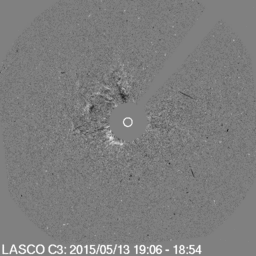Eruptive C9 solar flare, earth-directed CME
Thursday, 14 May 2015 10:10 UTC

A filament eruption (see video) near earth-facing sunspot region 2345 was associated with yesterday's strongest solar flare: C9.2 at 18:18 UTC. A Type II radio sweep was associated with this event and a faint asymmetrical full halo coronal mass ejection was launched towards Earth and could impact Earth this weekend.


Images: SOHO LASCO coronagraph animations showing the earth-directed coronal mass ejection. Notice the faint outline covering 360 degrees around the coronagraph.
While the coronal mass ejection doesn't look all too strong, the full halo outline means it is likely we will at least a glancing blow from this plasma cloud. Most of the ejecta can be seen flying of to the north but an earth-directed component is there. A preliminary analysis of the speed of this CME gives us a rather slow speed of around 400km/s to 450km/s but with only one source to go on this is still a preliminary speed. A possible arrival data for this coronal mass ejection would be late on Saturday (16 May) or Sunday (17 May) with active geomagnetic conditions to perhaps minor G1 geomagnetic storm levels being possible.
Coronal hole solar wind stream affecting Earth
A coronal hole high speed solar wind stream is currently affecting Earth and a moderate G2 geomagnetic storm was detected during the early hours of 13 May. This caused vivid aurora displays at high latitude locations like in Canada where Zoltan Kenwell captured some stunning pictures!

For more of his work visit this page.
Thank you for reading this article! Did you have any trouble with the technical terms used in this article? Our help section is the place to be where you can find in-depth articles, a FAQ and a list with common abbreviations. Still puzzled? Just post on our forum where we will help you the best we can!
Latest news
Latest forum messages
Support SpaceWeatherLive.com!
A lot of people come to SpaceWeatherLive to follow the Solar activity or if there is a chance to see the aurora, but with more traffic comes higher costs to keep the servers online. If you like SpaceWeatherLive and want to support the project you can choose a subscription for an ad-free site or consider a donation. With your help we can keep SpaceWeatherLive online!
Space weather facts
| Last X-flare | 2025/12/08 | X1.1 |
| Last M-flare | 2025/12/21 | M1.3 |
| Last geomagnetic storm | 2025/12/21 | Kp5 (G1) |
| Spotless days | |
|---|---|
| Last spotless day | 2022/06/08 |
| Monthly mean Sunspot Number | |
|---|---|
| November 2025 | 91.8 -22.8 |
| December 2025 | 116.9 +25.1 |
| Last 30 days | 109 +22.2 |





